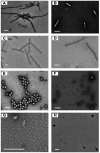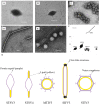Isolation of archaeal viruses with lipid membrane from Tengchong acidic hot springs
- PMID: 37065132
- PMCID: PMC10101205
- DOI: 10.3389/fmicb.2023.1134935
Isolation of archaeal viruses with lipid membrane from Tengchong acidic hot springs
Abstract
Archaeal viruses are one of the most mysterious parts of the virosphere because of their diverse morphologies and unique genome contents. The crenarchaeal viruses are commonly found in high temperature and acidic hot springs, and the number of identified crenarchaeal viruses is being rapidly increased in recent two decades. Over fifty viruses infecting the members of the order Sulfolobales have been identified, most of which are from hot springs distributed in the United States, Russia, Iceland, Japan, and Italy. To further expand the reservoir of viruses infecting strains of Sulfolobaceae, we investigated virus diversity through cultivation-dependent approaches in hot springs in Tengchong, Yunnan, China. Eight different virus-like particles were detected in enrichment cultures, among which five new archaeal viruses were isolated and characterized. We showed that these viruses can infect acidophilic hyperthermophiles belonging to three different genera of the family Sulfolobaceae, namely, Saccharolobus, Sulfolobus, and Metallosphaera. We also compared the lipid compositions of the viral and cellular membranes and found that the lipid composition of some viral envelopes was very different from that of the host membrane. Collectively, our results showed that the Tengchong hot springs harbor highly diverse viruses, providing excellent models for archaeal virus-host studies.
Keywords: Sulfolobaceae; Tengchong; archaeal virus; hot springs; viral membrane lipid.
Copyright © 2023 Feng, Li, Tian, Yang, Liu, Zhang and Zeng.
Conflict of interest statement
The authors declare that the research was conducted in the absence of any commercial or financial relationships that could be construed as a potential conflict of interest.
Figures





Similar articles
-
New virus isolates from Italian hydrothermal environments underscore the biogeographic pattern in archaeal virus communities.ISME J. 2020 Jul;14(7):1821-1833. doi: 10.1038/s41396-020-0653-z. Epub 2020 Apr 22. ISME J. 2020. PMID: 32322010 Free PMC article.
-
A comprehensive census of microbial diversity in hot springs of Tengchong, Yunnan Province China using 16S rRNA gene pyrosequencing.PLoS One. 2013;8(1):e53350. doi: 10.1371/journal.pone.0053350. Epub 2013 Jan 9. PLoS One. 2013. PMID: 23326417 Free PMC article.
-
New archaeal viruses discovered by metagenomic analysis of viral communities in enrichment cultures.Environ Microbiol. 2019 Jun;21(6):2002-2014. doi: 10.1111/1462-2920.14479. Epub 2019 Jan 8. Environ Microbiol. 2019. PMID: 30451355 Free PMC article.
-
Archaeal Viruses from High-Temperature Environments.Genes (Basel). 2018 Feb 27;9(3):128. doi: 10.3390/genes9030128. Genes (Basel). 2018. PMID: 29495485 Free PMC article. Review.
-
Hot crenarchaeal viruses reveal deep evolutionary connections.Nat Rev Microbiol. 2006 Jul;4(7):520-8. doi: 10.1038/nrmicro1444. Epub 2006 Jun 6. Nat Rev Microbiol. 2006. PMID: 16755285 Review.
Cited by
-
Influence of different sample preparation techniques on imaging viruses and virus-like particles by scanning electron and scanning transmission electron microscopes.Front Microbiol. 2023 Nov 14;14:1279720. doi: 10.3389/fmicb.2023.1279720. eCollection 2023. Front Microbiol. 2023. PMID: 38033599 Free PMC article.
References
-
- Baquero D., Contursi P., Piochi M., Bartolucci S., Liu Y., Cvirkaite-Krupovic V., et al. . (2020b). New virus isolates from Italian hydrothermal environments underscore the biogeographic pattern in archaeal virus communities. ISME J. 14, 1821–1833. doi: 10.1101/2020.01.16.907410, PMID: - DOI - PMC - PubMed
LinkOut - more resources
Full Text Sources

